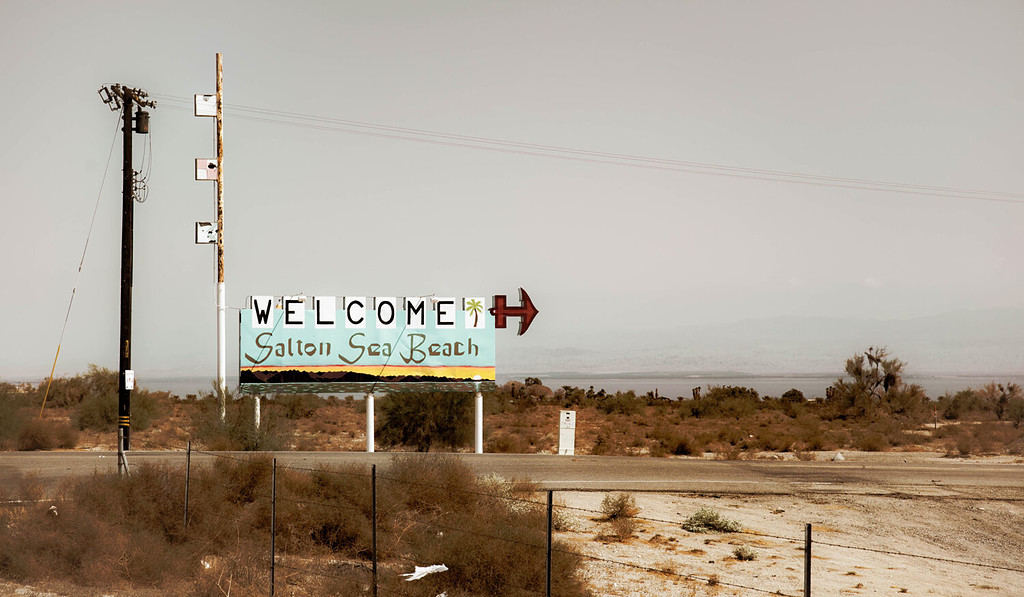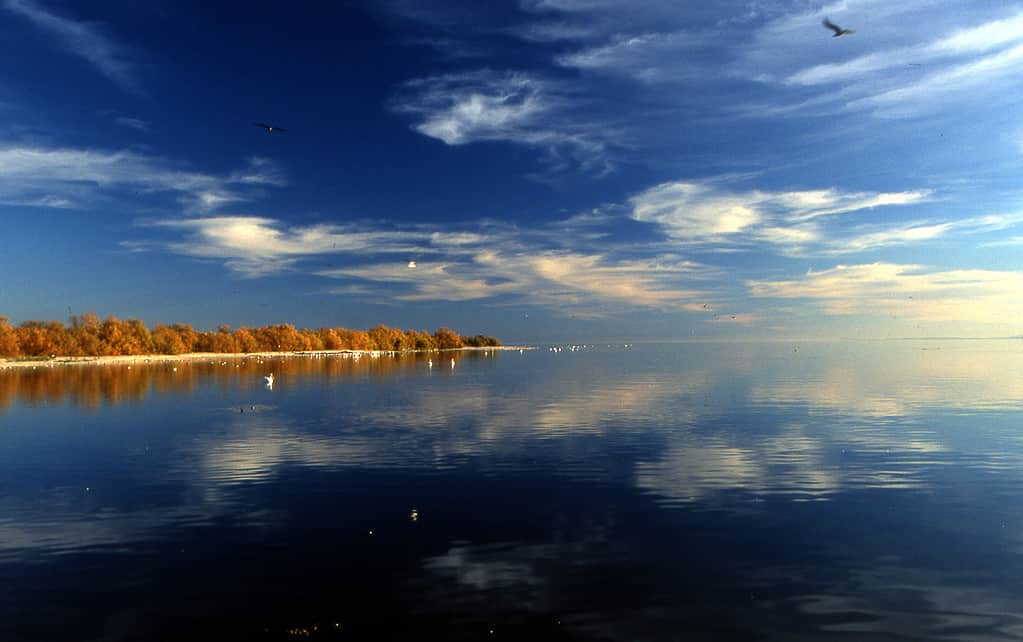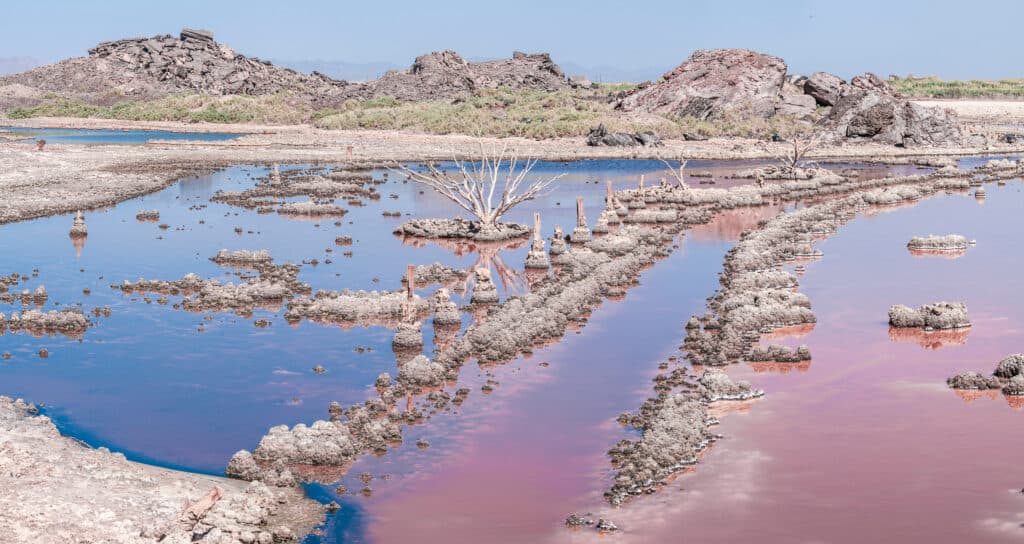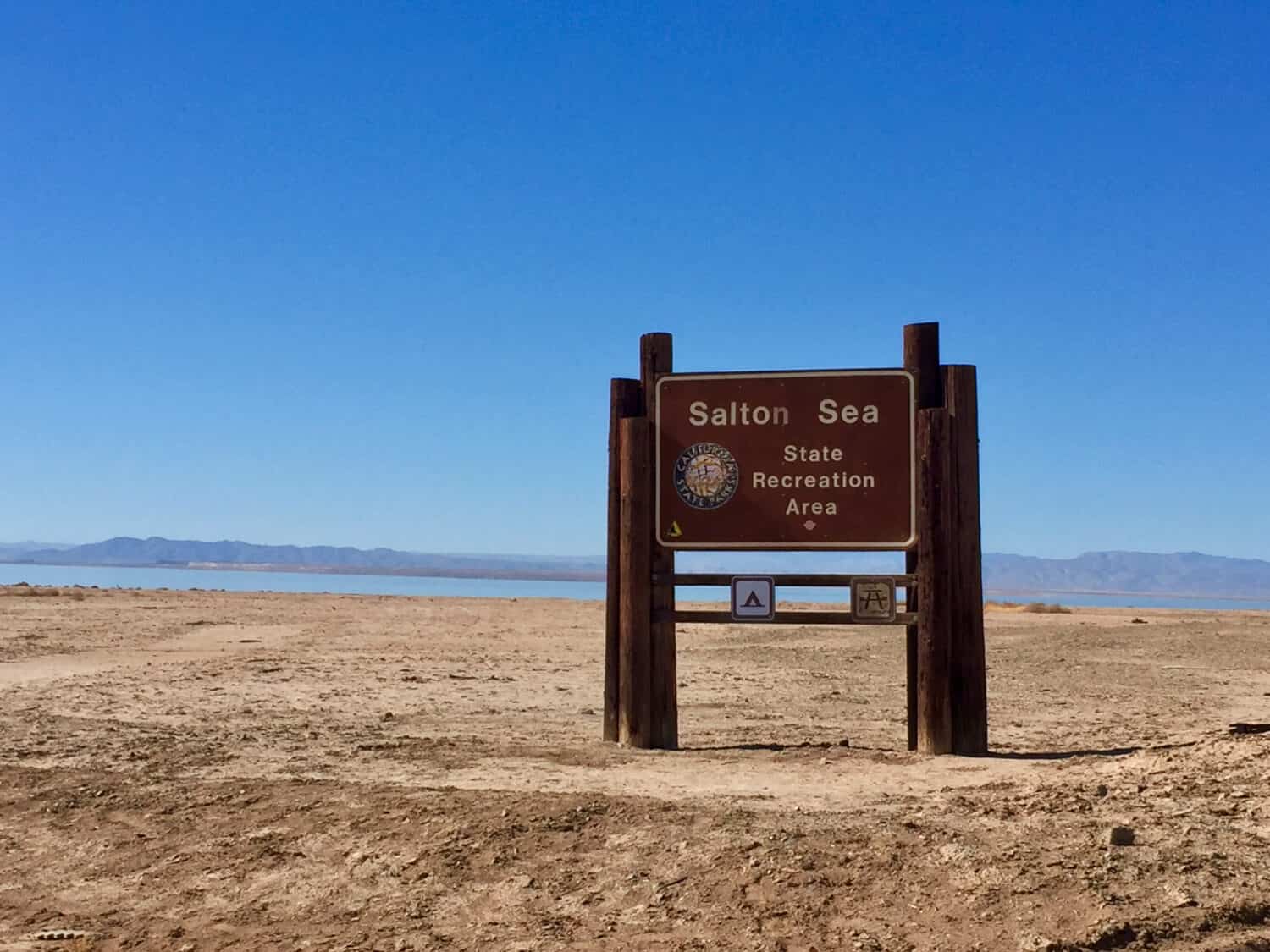The Salton Sea is an enigmatic body of water nestled in Southern California‘s Imperial Valley. It has long captured the fascination of scientists, environmentalists and public folks. This is because this unique and somewhat mysterious inland sea has had a strange history and has sparked numerous discussions and debates surrounding its future. The main question: will the Salton Sea ever completely dry up? What are the issues surrounding its existence, and why is there growing concern about its future? In this article, we will delve into all of these questions.

Aerial view of The Salton Sea, surrounded by the Imperial Valley and the Mojave Desert
©Thomas Barrat/Shutterstock.com
What is the Salton Sea?
The Salton Sea, often referred to as California’s “accidental sea,” is not an actual sea but a saline lake located in the southeastern corner of the Golden State. It occupies the lowest part of the Salton Sink, which is a geological depression that stretches across the Imperial and Coachella Valleys. The lake’s current form was created by an engineering mishap in the early 20th century.
Historical Origins
The Salton Sea’s origins can be traced back to the early 1900s when engineers attempted to divert water from the Colorado River into the arid Coachella Valley for agricultural purposes. The goal was to use the river’s water resources to transform the desert into productive farmland. However, due to engineering and management failures, water flowed uncontrollably into the Salton Sink, creating the Salton Sea. By the time engineers managed to contain the breach, the Salton Sea had already formed.
Geographic Features
Today, the Salton Sea is approximately 343 square miles, making it the largest lake in California by surface area. It is situated 227 feet below sea level, making it one of the lowest points in the United States. The lake’s water is brackish and has a higher salinity level than that of the Pacific Ocean. Despite its accidental creation, the Salton Sea has become an oasis for birds and other wildlife, attracting thousands of species throughout the year.
What Are The Issues Surrounding Salton Sea?
While the Salton Sea may seem like a picturesque desert oasis, it is not without its challenges and controversies. Several critical issues surround the Salton Sea, ranging from environmental concerns to public health risks.
1. Salinity and Water Quality
One of the most pressing issues facing the Salton Sea is its increasing salinity. The lake receives inflows from agricultural runoff, which carry fertilizers, pesticides, and other pollutants. As the water evaporates under the desert sun, the salts and minerals concentrate, leading to a rise in salinity levels. High salinity as well as nutrient concentrations can be harmful to aquatic life, impacting fish and other organisms. This is because high concentration of nutrients can also give rise to algae, leading to lake anoxia through eutrophication.
2. Declining Water Levels
The Salton Sea’s water levels have been steadily declining due to factors such as reduced agricultural runoff and increased water diversions for urban areas. This reduction in water inflow exposes vast areas of lakebed, which can release toxic dust and expose contaminated soil.
3. Air Quality and Public Health
The exposed lakebed can become a significant source of airborne dust, carrying fine particulate matter and toxins. These dust storms not only pose health risks to nearby communities but can also impact air quality in the region. The Imperial Valley, in particular, has faced challenges related to poor air quality and its associated health consequences.
4. Wildlife Habitat
The Salton Sea has been a crucial habitat for migratory birds along the Pacific Flyway, providing essential stopover points during their journeys. However, as water levels drop and salinity rises, the lake’s ability to sustain these habitats is compromised. This has led to declines in bird populations, raising concerns about the loss of biodiversity and the potential collapse of these fragile ecosystems.

©Tilted Hat Productions/Shutterstock.com
Why Are We Worried About The Salton Sea Drying?
The growing concern surrounding the Salton Sea primarily stems from the fear that it may eventually dry up entirely. This would have far-reaching consequences for the environment, public health, and the surrounding communities.
1. Environmental Impact
The Salton Sea’s disappearance would be catastrophic for the environment. As water levels decline, the exposed lakebed could release harmful chemicals and pollutants into the air, affecting both wildlife and human health. The loss of crucial habitats birds could also lead to population declines and disrupt ecosystems along the Pacific Flyway.
2. Public Health Risks
Dust storms generated by the exposed lakebed can pose severe health risks to the nearby communities. Fine particulate matter and toxic substances carried by the dust can lead to respiratory problems, especially in vulnerable populations.
3. Economic Impact
The Salton Sea region has faced economic challenges for years and the lake’s complete drying could exacerbate these issues. Property values could decline, agriculture could be impacted, and businesses that rely on the tourism generated by the lake could suffer.
4. Legal and Political Implications
The Salton Sea’s management and preservation has been a concern and a source of legal and political disputes for decades. Various stakeholders, including state and federal agencies, environmental organizations, and local communities, have diverse interests and priorities. The drying of the lake could lead to further legal battles and political tensions.

Will the Salton Sea Completely Dry?
The question of whether the Salton Sea will ultimately dry up is a complex and contentious one. This is because people and communities control the fate of the lake and it depends on politicians to make sure that the lake doesn’t completely dry.
Factors Influencing the Salton Sea’s Future
Water Management
The management of water resources in the region is a critical factor. Efforts to mitigate water loss from the lake, such as importing water and working towards habitat restoration, can impact its future.
Climate Change
Changing weather patterns, increasing temperatures and prolonged droughts in the region due to climate change can also affect the Salton Sea’s water supply.
Policy and Funding
Government policies and funding allocations also play a vital role in determining the lake’s future. Investments in conservation, restoration and dust suppression projects can significantly impact its resilience.
Stakeholder Collaboration
Collaboration among various stakeholders, including state and federal agencies, environmental organizations, and local communities, can lead to more effective strategies for preserving the Salton Sea.

The Imperial Valley in California is extremely dry. It has no natural rivers and needed water diverted to the region.
©Nick Pecker/Shutterstock.com
What Will Happen If The Salton Sea Dries?
The prospect of the Salton Sea drying up is scary. This is because it could have significant consequences that would impact the environment, public health, the economy and the broader region. Understanding these potential outcomes, therefore, is essential to addressing the issues surrounding the lake’s future.
1. Environmental Consequences:
As mentioned before, the Salton Sea has long served as a vital habitat for wildlife, particularly for migratory birds along the Pacific Flyway. If the lake were to dry up, the loss of these crucial wetland habitats would disrupt ecosystems and have severe consequences for bird populations. This is because many species that rely on the Salton Sea as a stopover point during their migrations would face the challenge of finding alternative sources of food and for shelter.
The disappearance of the Salton Sea would therefore likely lead to a decline in biodiversity, affecting not only birds but also other aquatic life forms, including fish and invertebrates. Many species that have adapted to the saline conditions of the lake would also face challenges in finding suitable alternative habitats, especially if the lake becomes more saline.
As the lake dries, it exposes vast stretches of lakebed that contain accumulated salts, minerals, and contaminants. This exposed lakebed can become a significant source of airborne dust, carrying fine particulate matter and toxins. Dust storms can carry these harmful substances over long distances, posing health risks to both wildlife and nearby communities.
2. Public Health Risks:
As mentioned before, dust storms generated by the exposed lakebed can lead to deteriorating air quality in the region. This is because fine particulate matter, pollutants, and contaminants carried by the dust can have serious health consequences. Residents in nearby communities, including the Imperial Valley, could also face increased risks of respiratory illnesses such as asthma and bronchitis.
Prolonged exposure to airborne particulate matter from the dried lakebed can lead to respiratory problems, especially in vulnerable populations such as children and the elderly. This could strain local healthcare systems and increase healthcare costs.
3. Economic Impact:
The drying of the Salton Sea could also negatively impact property values in the surrounding areas. Homes and businesses located near the lake may see a decline in value due to the health risks and the biodiversity decrease, affecting property owners and potentially leading to economic instability in the region.
The agricultural industry in the Imperial Valley also relies on water from the Colorado River and the Salton Sea’s inflows for irrigation. Changes in water availability and quality due to the lake’s decline could impact crop yields and agricultural productivity.
Finally, the Salton Sea has been a destination for tourism and recreational activities, including boating, fishing, and birdwatching. The loss of the lake could also deter tourists and affect local businesses that rely on tourism-related revenue.
4. Legal and Political Implications:
The drying of the Salton Sea would likely lead to legal and political disputes among various stakeholders, including state and federal agencies, environmental organizations and local communities. Therefore, disputes over water management, habitat restoration and dust suppression efforts could result in protracted legal battles and increased political tensions in the region.
In conclusion, the drying of the Salton Sea is not merely an environmental issue. It has far-reaching consequences that affect public health, the economy and the legal and political landscape of the region.

©Nick Pecker/Shutterstock.com
What Issues Do We Need to Focus On?
The Salton Sea’s future is fraught with challenges, and addressing these issues requires a multifaceted approach. Some ideas are listed below:
1. Water Management
Efficient water management is crucial to maintaining the Salton Sea’s water levels. Balancing the needs of agriculture, urban areas and the environment is a complex task that requires collaboration among stakeholders and effective water allocation strategies. There have been few ventures that have been successful in doing all three, so effective compromise is necessary.
2. Habitat Restoration
Restoring and preserving habitats for wildlife, particularly those for migratory birds, is essential. Any efforts to create sustainable ecosystems and wetlands can help mitigate the loss of biodiversity.
3. Dust Suppression
To prevent harmful dust storms, dust suppression measures are imperative. These may include planting vegetation on exposed lakebeds to reduce erosion, applying dust suppressants and implementing land-use plans that minimizes dust-generating activities.
Thank you for reading! Have some feedback for us? Contact the AZ Animals editorial team.








